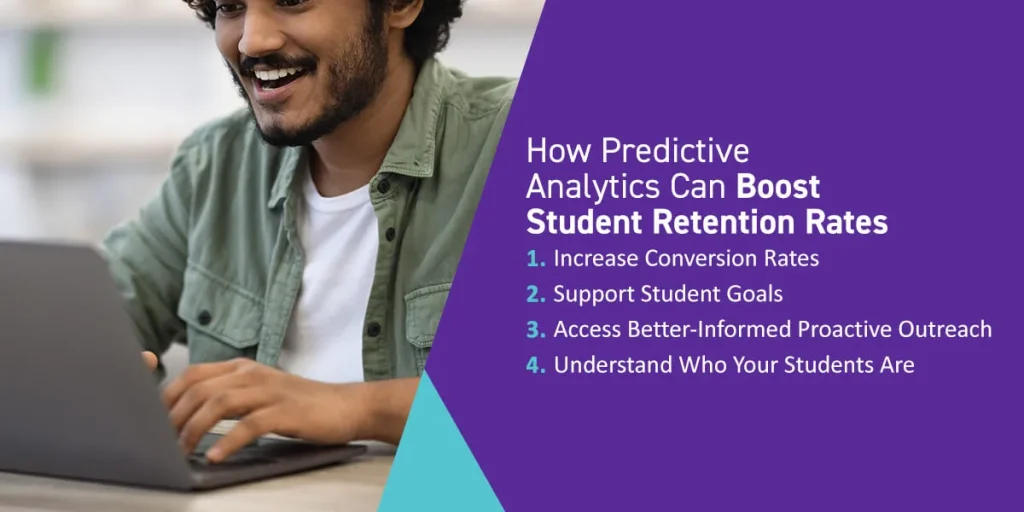




Predictive analytics’ application is unlimited, from helping determine inventory needs in retail to predicting patient needs in hospitals. One ever-growing issue predictive analytics is helping to solve is the growing college drop-out rate, which is about 33% of students.
For higher education institutions, the pressure is increasing to meet enrollment numbers, retain current students, and ensure those students make it to graduation while also working under tight budgets. Successfully navigating the mounting list of challenges is no easy task, but predictive analytics can ease some of this burden.
The higher education industry has coined the term ‘summer melt’ to describe enrolled students leaving for the summer and failing to return for classes in the fall. However, by using data analytics to gain deep student insights, colleges have been able to make smarter enrollment choices and decrease the threat of summer melt.

Predictive analytics is an untapped resource for many colleges and universities faced with the task of improving college retention. Through the compilation of data, analytics, and automation, institutions gain insights that can lead to well-informed enrollment decisions and the ability to analyze the trajectory of each student’s success in advance and intervene before it is too late.
This technology can lead to increased conversion rates and better-informed proactive outreach — core components needed to effectively address the growing drop-out rate. Now, let’s discuss why and how predictive analytics can better student retention efforts:
For higher education institutions, predictive analytics can assist in meeting enrollment goals. For instance, colleges and universities that aim to increase conversion rates in the enrollment process can leverage big data and predictive analytics to ensure that those enrolled have a high chance of staying at the institution and completing their higher education journey at a school.
You’re probably wondering how and what insights are compiled to form a prediction regarding a student’s success. To answer this question, the technology analyzes a combination of data points that include metrics such as academic interests, engagement, test scores, and GPA. The compilation of these individual data sets is then leveraged through Enterprise Data Systems where predictive analytics steps in to make automatic, data-driven determinations on which individuals present the highest predictive strength.
With admissions recruiters reviewing thousands of applications, predictive analytics and automation can assist in determining the students that have the highest likelihood of retention. As colleges and universities navigate budget restrictions, limited staff, and a growing list of additional responsibilities, every enrollment decision needs to be strategic, intentional, and well-informed if they want to maximize success as an institution. Predictive analytics makes that possible.
Students attend higher education institutions for many reasons. Some students are looking for a more advanced education in a specific field, while others are looking to kickstart their careers. From undergraduate programs and internships to graduate studies, research opportunities, and full-time jobs, your predictive analytics system can help students stay on their intended educational track.
For example, many schools have specific academic performance requirements for various programs, like pre-med and business schools. Students might have to submit applications to meet minimum thresholds before they can enroll in classes. Students who fall behind or cannot enroll become more at risk for dropping out or transferring because their needs are not being met at your school.
Academic advisors can use predictive analytics to help keep students on track to accomplish their goals. When they meet with students, they might ask them about their interest in other programs or industries, so they can better track their progress. While students might be able to meet university academic standards, advisors can ensure they can still meet their program requirements for GPA, involvement, and pre-requisite courses. Predictive analytics can highlight when students might experience grade drops or other obstacles that can keep them from their goals.
Predictive analytics isn’t only useful for enrolling new students, but also for retaining current ones. Having a predictive solution that notifies professionals and the individual students of their change in performance can allow institutions to intervene before it is too late. The importance of early intervention and closed-loop transparency is crucial, as research shows that students who drop out are likely to never return.
For community colleges, in particular, students’ personal lives vary dramatically — some may have children, families, or full-time jobs — which places them at a higher risk of falling behind and placing other life aspects in front of their education. With predictive analytics, performance indicators and student data are pulled from enterprise resource planning (ERP) systems, learning management systems (LMS), and additional outlets that house information that can inform predictions regarding the risk of attrition, like student interactions with staff.
Having a data-driven solution gives college staff and students the right information at the right time. With this, the solution can alert the student of their performance and hold them accountable at every step. Another aspect of predictive analytics for outreach is the concept of risk factors. Big data is utilized to place students in risk categories:
When a student experiences a change in circumstance or performance, that risk level may change. Through automation and big data analysis, staff members can instantly be notified of the change and initiate proactive outreach to assist in resolving the issue causing a negative impact on their performance and success.
Predictive analytics gives college and university staff the ability to read between the lines of each student, helping to enroll students that show promise of completion and targeting when a student needs help before it’s too late. As we navigate an evolving landscape and higher education environment, leveraging predictive analytics can help not only provide students with crucial support, but set institutions up for long-term success.
Predictive analytics relies on historical and current data to make its predictions. By collecting and reviewing your current and historical data, predictive analytics can help you understand your student populations. You can receive an overview of who they are and their various performance metrics, so you can implement better strategies, programs, and services more catered to their needs.
By knowing who your students are and tailoring your actions and initiatives to your campus, you can boost student retention by creating a campus that better supports your students. Programs and services that match their needs and serve various communities on campus can help students feel supported and seen by faculty, increasing connections with your institution and encouraging them to stay enrolled.
Predictive analytics in higher education can be a powerful solution that provides higher education administrators with the data they need to best help their student body. When considering this system for your institution, try these tips to optimize your integration:

Watermark offers comprehensive and intuitive data collection and management solutions for higher education institutions. By storing all data in centralized solutions, you can increase faculty and administrator accessibility and visibility to optimize your solution.
Request a demo today to discover how Watermark can transform your school’s data.





























































































































































































































































































































































































